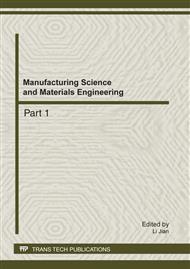[1]
Xu Binshi, Equipment remanufacturing theory and technology equipment remanufacturing engineering. Beijing: National Defense Industry Press, (2007).
Google Scholar
[2]
Rao J.R. Jagannatha, Badhrinath Krishnakumar, Pakala Rama, Mistree Farrokh, A Study of Optimal Design Under Conflict Using Models of Multi-Player Games, Engineering Optimization, vol. 28, 1997, pp.63-94.
DOI: 10.1080/03052159708941127
Google Scholar
[3]
Meng Xiuli, Yi Hong, Ni Zhonghua, Liu Ying . Research on Negotiation Method of Goal Conflict in Collaborative Design Based on Game Theory, China Mechanical Engineering, vol. 15 , Dec. 2004, pp: 2190-2194.
Google Scholar
[4]
Xiong Guangleng, Ma Haibo. Research on Conflict Negotiation in Concurrent Design, , Control And Decision, Nov. 2001, pp: 721-724.
Google Scholar
[5]
Huang Tao. The tutorial of game theory. Beijing: Capital University Economics&Business Press. May (2004).
Google Scholar
[6]
Roger B. Myerson. Game theory analysis of Conflict. Beijing: China Economics Press. Jan. (2001).
Google Scholar
[7]
Qi Yunhui. The Research of Green Design Theory and Method based on product energy conservation, Hefei, Hefei university of technology, Sep. (2006).
Google Scholar
[8]
Awu Fanglang. The design of production. Beijing: China Machine Press. Apr. (1988).
Google Scholar
[9]
Huang Haihong, Liu Zhifeng, Zhang Lei, John W. Sutherland. Materials selection for environmentally conscious design via a proposed life cycle environmental performance index, International Journal of Advanced Manufacturing Technology, vol. 44, Feb. 2009, pp.1073-1082.
DOI: 10.1007/s00170-009-1935-9
Google Scholar
[10]
Erik Sundin, Mattias Lindahl, Rethinking Product Design for Remanufacturing to Facilitate Integrated Product Service Offerings, 16th IEEE International Symposium on Electronics and the Environment, (ISEE) , IEEE Press, May. 2008, doi: 10. 1109/ISEE. 2008. 4562901.
DOI: 10.1109/isee.2008.4562901
Google Scholar
[11]
Huang Qi, Sun Shouqian, Xu Yurong. Research on Conflict Harmonization in Constraint-Based Collaborated Design Process, China Mechanical Engineering, vol. 17 Jan. 2006, pp: 160-163.
Google Scholar
[12]
Lily H. Shu, Woodie C. Flowers. Application of a design-for-remanufacture framework to the selection of product life-cycle fastening and joining methods, Robotics and Computer Integrated Manufacturing. vol. 15 , Jun. 1999, pp: 179-190.
DOI: 10.1016/s0736-5845(98)00032-5
Google Scholar
[13]
L.H. Shu, E. Hacco, Biomimetic concept generation applied to design for remanufacturing, " Proceedings of DETC, 02 ASME 2002 Design Engineering Technical Conferences and Computers and Information in Engineering Conference Montreal, Canada, Sep, (2002).
DOI: 10.1115/detc2002/dfm-34177
Google Scholar


